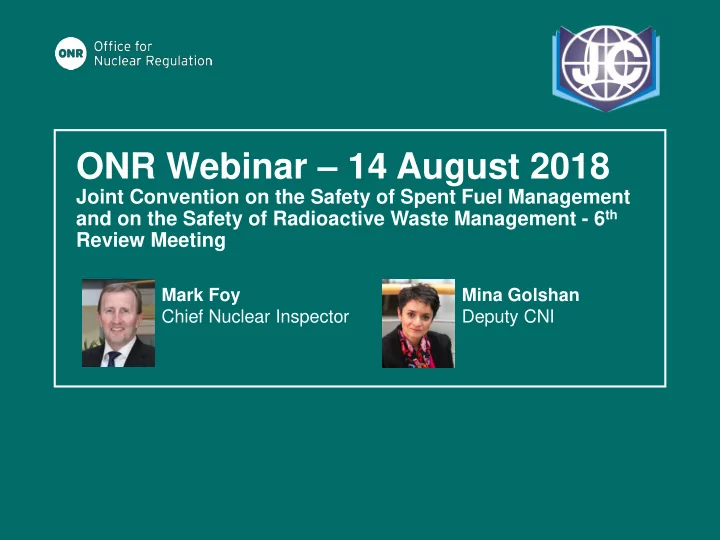

ONR Webinar – 14 August 2018 Joint Convention on the Safety of Spent Fuel Management and on the Safety of Radioactive Waste Management - 6 th Review Meeting Mark Foy Mina Golshan Chief Nuclear Inspector Deputy CNI
What is the Joint Convention (JOC) ? A binding international legal instrument which came into force in 1997. It seeks to influence and promote improvements to spent fuel and radioactive waste management globally 78 Contracting Parties (CPs) have ratified it. CPs must demonstrate they meet the obligations of the JOC and submit themselves to a process of peer review. No enforcement in place so improvements are sought through peer scrutiny during triennial Review Meetings of the CPs. 2
How does the JOC Work in Practice ?
Role of the IAEA and the Appointed Officers • The JOC is managed under auspices of IAEA who act as the secretariat and repository and who help manage and host the triennial Review Meetings (RM) in Vienna. • Officers are elected to facilitate the efficient working of the RM i.e. President, Vice Presidents, Country Group Chairs, Vice Chairs, Coordinators and Rapporteurs • CPs are split into Country Groups (CG) to efficiently manage the peer review process: these all have a Chair and distill out the main challenges and issues from their Groups. • UK members are often elected; at 6 th RM it was a CG Chair and a Rapporteur. 4
2016 – Officers to the JOC appointed 2017 – UK submitted its 6 th national report to the JOC, drafted by ONR with contributions from others, notably the environment agencies. Approved by BEIS Minister CPs review each other’s reports in advance of the meeting and exchange written questions and answers UK (BEIS, ONR, EA) presented our report to the RM in Vienna and fielded questions from CP in our designated Country Group and from other CPs. 5
UK Organisations who Contributed BEIS (4) Natural Resources Wales Civil Aviation Authority Northern Ireland Environment Agency Department of Health Nuclear Decommissioning Authority Dounreay Site Restoration Limited (1) EDF Energy Limited Office for Nuclear Regulation (12)(2 were officers) Environment Agency (3) Radioactive Waste Management Limited Food Standards Agency Scottish Environment Protection Agency GE Healthcare Scottish Government (1) Public Health England Sellafield Limited (2) UK Home Office Springfield Fuels Limited Low Level Waste Repository Limited (1) Urenco UK Limited Magnox Limited Welsh Government Maritime Coastguard Agency National Nuclear Laboratory 6
What the UK presented to the 6 th Review Meeting in Vienna
Summary of the UK presentation National overview of Sites, Laws, Policy and Strategy UK Nuclear Sites covered by the Convention (not defence) UK Regulatory Bodies (EA, NRW, SEPA and NI) Laws, Regulations, Policies and Strategies Overview of significant changes since the 5 th Review meeting UK ‘s progress with Higher Activity Waste (Geological Disposal Facility) Update on Waste Strategies Activities related to the Fukushima Daiichi accident Updates on major decommissioning and waste programmes particularly at Sellafield and the 12 Magnox Limited sites Integrated Regulatory Review Service (IRRS) missions 8
How was our presentation received ?
One Good Practice – Use of the waste hierarchy to divert LLW from the LLWR at Drigg Diversion of wastes from LLWR FY 2017-18 Landfill One of only six Combustion countries Metallic treatment LLWR Extends lifetime of LLWR by 100 years
Four Areas of Good Performance Identified 1. The approach to regulating late stages of decommissioning including the associated guidance has been successfully trialled at three lead and learn sites across the UK. 2. Progress in delivering Magnox defuelling and Spent Fuel reprocessing to meet commitments under the OSPAR Convention. 3. Substantial progress in providing engineered access to retrieve wastes from legacy stores at Sellafield 4. Sellafield - Several thousand TBq of potentially highly mobile legacy wastes retrieved from legacy facilities and packaged to modern standards for storage.
Challenges Identified for the UK – UK exit from EU – Continued remediation of high hazard facilities at Sellafield – Identifying a site for a deep Geological Disposal Facility – UK’s spent fuel and Radioactive Waste management infrastructure – Sustaining the UK’s nuclear skills base 12
Summary of findings across other Contracting Parties
Overall findings • Report and peer review continues to highlight progress and remaining challenges with increasing commitment from CPs (attendance increased by 10%) • Areas of progress since 2015: • Geological disposal • National policies and strategies & programmes for spent fuel and radioactive waste; • Construction, and commissioning of new or expanded storage facilities for spent fuel; • Safety of spent fuel storage in light of the Fukushima Daiichi accident; • The remediation of sites containing legacy waste including from mining and minerals processing activities; • Recruiting, training, maintaining and developing human resources to address emerging issues and expanding programmes. 14
Highlight From the Country Group Discussions • Extending the capacity and or lifetime of facilities for the storage of spent fuel • Integrated Regulatory Review Service (IRRS) missions or follow up missions were requested by many Contracting Parties and carried out by the IAEA • Positive Regional co-operation • Challenges associated with former Uranium mines 15
Measures to improve safety • A number of Contracting Parties are undertaking improvements to their legal and regulatory frameworks • Increasing the capacity of regulatory authorities, improving licensing processes for disposal facilities • A number of Contracting Parties reported on the development of new facilities for the near surface disposal of low and very low level radioactive waste • Retrieval and treatment of historical waste was taking place in some Contracting Parties 16
Reflections from Country Group Chair - Mina Golshan
Chief Nuclear Inspector’s Reflections – Mark Foy
Q&A on Joint Convention
Thank you for attending our webinar contact@onr.gov.uk
Recommend
More recommend